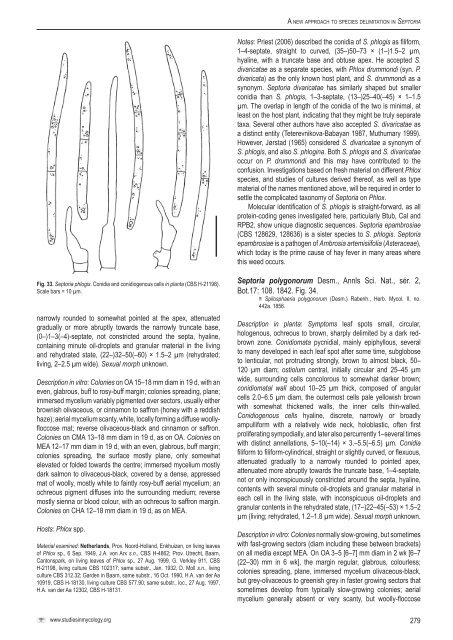A new approach to species delimitation in Septoria - CBS - KNAW
A new approach to species delimitation in Septoria - CBS - KNAW
A new approach to species delimitation in Septoria - CBS - KNAW
Create successful ePaper yourself
Turn your PDF publications into a flip-book with our unique Google optimized e-Paper software.
A <strong>new</strong> <strong>approach</strong> <strong>to</strong> <strong>species</strong> <strong>delimitation</strong> <strong>in</strong> Sep<strong>to</strong>riaNotes: Priest (2006) described the conidia of S. phlogis as filiform,1–4-septate, straight <strong>to</strong> curved, (35–)50–73 × (1–)1.5–2 µm,hyal<strong>in</strong>e, with a truncate base and obtuse apex. He accepted S.divaricatae as a separate <strong>species</strong>, with Phlox drummondi (syn. P.divaricata) as the only known host plant, and S. drummondi as asynonym. Sep<strong>to</strong>ria divaricatae has similarly shaped but smallerconidia than S. phlogis, 1–3-septate, (13–)25–40(–45) × 1–1.5µm. The overlap <strong>in</strong> length of the conidia of the two is m<strong>in</strong>imal, atleast on the host plant, <strong>in</strong>dicat<strong>in</strong>g that they might be truly separatetaxa. Several other authors have also accepted S. divaricatae asa dist<strong>in</strong>ct entity (Teterevnikova-Babayan 1987, Muthumary 1999).However, Jørstad (1965) considered S. divaricatae a synonym ofS. phlogis, and also S. phlog<strong>in</strong>a. Both S. phlogis and S. divaricataeoccur on P. drummondi and this may have contributed <strong>to</strong> theconfusion. Investigations based on fresh material on different Phlox<strong>species</strong>, and studies of cultures derived thereof, as well as typematerial of the names mentioned above, will be required <strong>in</strong> order <strong>to</strong>settle the complicated taxonomy of Sep<strong>to</strong>ria on Phlox.Molecular identification of S. phlogis is straight-forward, as allprote<strong>in</strong>-cod<strong>in</strong>g genes <strong>in</strong>vestigated here, particularly Btub, Cal andRPB2, show unique diagnostic sequences. Sep<strong>to</strong>ria epambrosiae(<strong>CBS</strong> 128629, 128636) is a sister <strong>species</strong> <strong>to</strong> S. phlogis. Sep<strong>to</strong>riaepambrosiae is a pathogen of Ambrosia artemisiifolia (Asteraceae),which <strong>to</strong>day is the prime cause of hay fever <strong>in</strong> many areas wherethis weed occurs.Fig. 33. Sep<strong>to</strong>ria phlogis. Conidia and conidiogenous cells <strong>in</strong> planta (<strong>CBS</strong> H-21198).Scale bars = 10 µm.narrowly rounded <strong>to</strong> somewhat po<strong>in</strong>ted at the apex, attenuatedgradually or more abruptly <strong>to</strong>wards the narrowly truncate base,(0–)1–3(–4)-septate, not constricted around the septa, hyal<strong>in</strong>e,conta<strong>in</strong><strong>in</strong>g m<strong>in</strong>ute oil-droplets and granular material <strong>in</strong> the liv<strong>in</strong>gand rehydrated state, (22–)32–50(–60) × 1.5–2 µm (rehydrated;liv<strong>in</strong>g, 2–2.5 µm wide). Sexual morph unknown.Description <strong>in</strong> vitro: Colonies on OA 15–18 mm diam <strong>in</strong> 19 d, with aneven, glabrous, buff <strong>to</strong> rosy-buff marg<strong>in</strong>; colonies spread<strong>in</strong>g, plane;immersed mycelium variably pigmented over sec<strong>to</strong>rs, usually eitherbrownish olivaceous, or c<strong>in</strong>namon <strong>to</strong> saffron (honey with a reddishhaze); aerial mycelium scanty, white, locally form<strong>in</strong>g a diffuse woollyfloccosemat; reverse olivaceous-black and c<strong>in</strong>namon or saffron.Colonies on CMA 13–18 mm diam <strong>in</strong> 19 d, as on OA. Colonies onMEA 12–17 mm diam <strong>in</strong> 19 d, with an even, glabrous, buff marg<strong>in</strong>;colonies spread<strong>in</strong>g, the surface mostly plane, only somewhatelevated or folded <strong>to</strong>wards the centre; immersed mycelium mostlydark salmon <strong>to</strong> olivaceous-black, covered by a dense, appressedmat of woolly, mostly white <strong>to</strong> fa<strong>in</strong>tly rosy-buff aerial mycelium; anochreous pigment diffuses <strong>in</strong><strong>to</strong> the surround<strong>in</strong>g medium; reversemostly sienna or blood colour, with an ochreous <strong>to</strong> saffron marg<strong>in</strong>.Colonies on CHA 12–18 mm diam <strong>in</strong> 19 d, as on MEA.Hosts: Phlox spp.Material exam<strong>in</strong>ed: Netherlands, Prov. Noord-Holland, Enkhuizen, on liv<strong>in</strong>g leavesof Phlox sp., 6 Sep. 1949, J.A. von Arx s.n., <strong>CBS</strong> H-4862; Prov. Utrecht, Baarn,Can<strong>to</strong>nspark, on liv<strong>in</strong>g leaves of Phlox sp., 27 Aug. 1999, G. Verkley 911, <strong>CBS</strong>H-21198, liv<strong>in</strong>g culture <strong>CBS</strong> 102317; same substr., Jan. 1932, D. Moll s.n., liv<strong>in</strong>gculture <strong>CBS</strong> 312.32; Garden <strong>in</strong> Baarn, same substr., 16 Oct. 1990, H.A. van der Aa10919, <strong>CBS</strong> H-18130, liv<strong>in</strong>g culture <strong>CBS</strong> 577.90; same substr., loc., 27 Aug. 1997,H.A. van der Aa 12302, <strong>CBS</strong> H-18131.Sep<strong>to</strong>ria polygonorum Desm., Annls Sci. Nat., sér. 2,Bot.17: 108. 1842. Fig. 34.≡ Spilosphaeria polygonorum (Desm.) Rabenh., Herb. Mycol. II, no.442a. 1856.Description <strong>in</strong> planta: Symp<strong>to</strong>ms leaf spots small, circular,hologenous, ochreous <strong>to</strong> brown, sharply delimited by a dark redbrownzone. Conidiomata pycnidial, ma<strong>in</strong>ly epiphyllous, several<strong>to</strong> many developed <strong>in</strong> each leaf spot after some time, subglobose<strong>to</strong> lenticular, not protrud<strong>in</strong>g strongly, brown <strong>to</strong> almost black, 50–120 µm diam; ostiolum central, <strong>in</strong>itially circular and 25–45 µmwide, surround<strong>in</strong>g cells concolorous <strong>to</strong> somewhat darker brown;conidiomatal wall about 10–25 µm thick, composed of angularcells 2.0–6.5 µm diam, the outermost cells pale yellowish brownwith somewhat thickened walls, the <strong>in</strong>ner cells th<strong>in</strong>-walled.Conidiogenous cells hyal<strong>in</strong>e, discrete, narrowly or broadlyampulliform with a relatively wide neck, holoblastic, often firstproliferat<strong>in</strong>g sympodially, and later also percurrently 1–several timeswith dist<strong>in</strong>ct annellations, 5–10(–14) × 3.–5.5(–6.5) µm. Conidiafiliform <strong>to</strong> filiform-cyl<strong>in</strong>drical, straight or slightly curved, or flexuous,attenuated gradually <strong>to</strong> a narrowly rounded <strong>to</strong> po<strong>in</strong>ted apex,attenuated more abruptly <strong>to</strong>wards the truncate base, 1–4-septate,not or only <strong>in</strong>conspicuously constricted around the septa, hyal<strong>in</strong>e,contents with several m<strong>in</strong>ute oil-droplets and granular material <strong>in</strong>each cell <strong>in</strong> the liv<strong>in</strong>g state, with <strong>in</strong>conspicuous oil-droplets andgranular contents <strong>in</strong> the rehydrated state, (17–)22–45(–53) × 1.5–2µm (liv<strong>in</strong>g; rehydrated, 1.2–1.8 µm wide). Sexual morph unknown.Description <strong>in</strong> vitro: Colonies normally slow-grow<strong>in</strong>g, but sometimeswith fast-grow<strong>in</strong>g sec<strong>to</strong>rs (diam <strong>in</strong>clud<strong>in</strong>g these between brackets)on all media except MEA. On OA 3–5 [6–7] mm diam <strong>in</strong> 2 wk [6–7(22–30) mm <strong>in</strong> 6 wk], the marg<strong>in</strong> regular, glabrous, colourless;colonies spread<strong>in</strong>g, plane, immersed mycelium olivaceous-black,but grey-olivaceous <strong>to</strong> greenish grey <strong>in</strong> faster grow<strong>in</strong>g sec<strong>to</strong>rs thatsometimes develop from typically slow-grow<strong>in</strong>g colonies; aerialmycelium generally absent or very scanty, but woolly-floccosewww.studies<strong>in</strong>mycology.org279
















